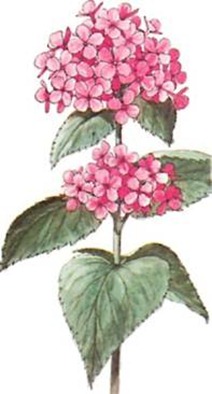





Tree planting time has arrived so it’s time to re-excavate the tree pit we dug earlier and plant our tree. Don’t worry if yours does not arrive the day you expected it: nurserymen have literally thousands of orders to send off. Be patient: your tree will come. Plant any time in fall when the ground is not too wet or not frozen solid. Staking and tying are very important: we show you how to do it right. With your tree planted, you’re halfway home in your garden.
Needs list: 1 tree slake; 1 strong tree tie, 1 pkt honesty seed.
Time budget: 4 hours in 2 weeks
Calm, warm days, often very sunny, typify this season’s weather: plants can suffer drought. Still nights encourage dew and even frost to form. Stray gales remind one autumn is still with us. Take back indoors house plants stood out for the summer. Keep lawn well mown right into winter.
 Honesty (Lunaria biennis) is about the nearest thing there is to a desirable weed. It will seed itself readily in your garden, but is no problem. You’ll soon learn to recognize the young plants with their attractive bright green, heart-shaped leaves. Just pull out the seedlings growing where you don’t want them. Leave them where you do. Like the wall-flower (Stage 10) honesty is a biennial: little plant first year, flowers and seed second year: finished. It’s grown as much for its coin-shaped, silvery, papery seed cases which last indefinitely indoors as dried flower decorations as for its showy heads of pink flowers. If you let seedlings grow on, you’ll get some with pure white flowers.
Honesty (Lunaria biennis) is about the nearest thing there is to a desirable weed. It will seed itself readily in your garden, but is no problem. You’ll soon learn to recognize the young plants with their attractive bright green, heart-shaped leaves. Just pull out the seedlings growing where you don’t want them. Leave them where you do. Like the wall-flower (Stage 10) honesty is a biennial: little plant first year, flowers and seed second year: finished. It’s grown as much for its coin-shaped, silvery, papery seed cases which last indefinitely indoors as dried flower decorations as for its showy heads of pink flowers. If you let seedlings grow on, you’ll get some with pure white flowers.
1. Collect seed from Shirley poppies, calendulas, nasturtiums, Canary creeper and sunflowers to sow next year.
2. Dead head calendulas, pelargoniums, fuchsias, petunias – there’s often a mini-spring in the fall – lots of fresh flowers.
3. Pinch back convolvulus and hope to encourage growth low down.
4. Check stakes are secure on gladioli and chrysanthemums.
5. Keep thyme and periwinkle well watered till established.
6. Tie in straggly shoots on pole beans – they’ll soon be in fruit.
7. Pinch out new growths on tomatoes, marrows/squashes, so that the plants concentrate on fruit production. Keep these vegetables well watered. Move tomato bags to the warmest, sunniest place in your garden.
8. Thin out carrots, radishes, lettuces: use thinnings to flavour salads, stews, broths.
9. Top up hollows in newly laid turf, using a soil/sand mix.
10. Watch out for late crop of weed seedlings and hoe them out of existence as soon as they appear.
11. Mulch your newly planted tree with lawn clippings, moss peat or compost from your own compost heap: keep watered.
Any day now the container-grown tree you ordered should arrive. If you forgot to order, it’s still not too late to get your garden centre to deliver one for you. Trees come in several types of container – but you treat them all much the same. When the tree arrives, put it in a shaded, sheltered place with sacking/burlap over its roots. Use the garage, garden shed, whatever. Prevents frost or wind damage. Re-excavate the tree-pit dug earlier (Stage 11). If you intend to heap the earth out on to the lawn, protect the grass by putting boards down first. Once the pit is excavated, fill it with water, then leave for 3 days before planting.
Next lay bricks/stones/rubble as a drainage layer for the tree. Move the tree in its container to the edge of the pit. Lift it by the container, not by the stem. Takes two people to move it. Lower tree in container into hole. Adjust level by sliding bricks, stones under container. Cut wires round container. Slide out base sheet of container if there is one. Start back filling with soil you excavated earlier. Wriggle container gently upwards as you fill. Firm soil every 6 in. Fill till the soil is level with the soil in the container. Firm soil again, leaving slight depression. Don’t soak. Get wife/friend to hold stem aside and drive sharpened stake vertically into the ground.
The stake should go well below the drainage layer. It should go in vertically, parallel with the tree stem, about 1-1/2 in. from it. Tie firmly just below main branches. Make sure no branches can rub against the stake. Take a coffee break. Then come back and soak the depression thoroughly. Finally sit back and admire your work. The success of your tree will depend on how well you planted it. A well-excavated hole, with plenty of fresh soil for the roots to grow into, will thrive.
Year 1 it won’t do a lot. Year 2 it will grow rapidly. Year 3 it will settle down to flowering and fruiting.
Two Hour Gardening Project: Stage 26 Climbing Plants and Pergolas
Two Hour Gardening Project: Stage 25 Getting To Know Your Garden
Two Hour Gardening Project: Stage 24 Propagation and Growing Herbs
Two Hour Gardening Project: Stage 21 Making Christmas Present Plants
Two Hour Gardening Project: Stage 18 Choosing Shrubs for the Garden
Two Hour Gardening Project: Stage 17 Fan Trained Fruit Trees
Copyright © www.100flowers.win Botanic Garden All Rights Reserved